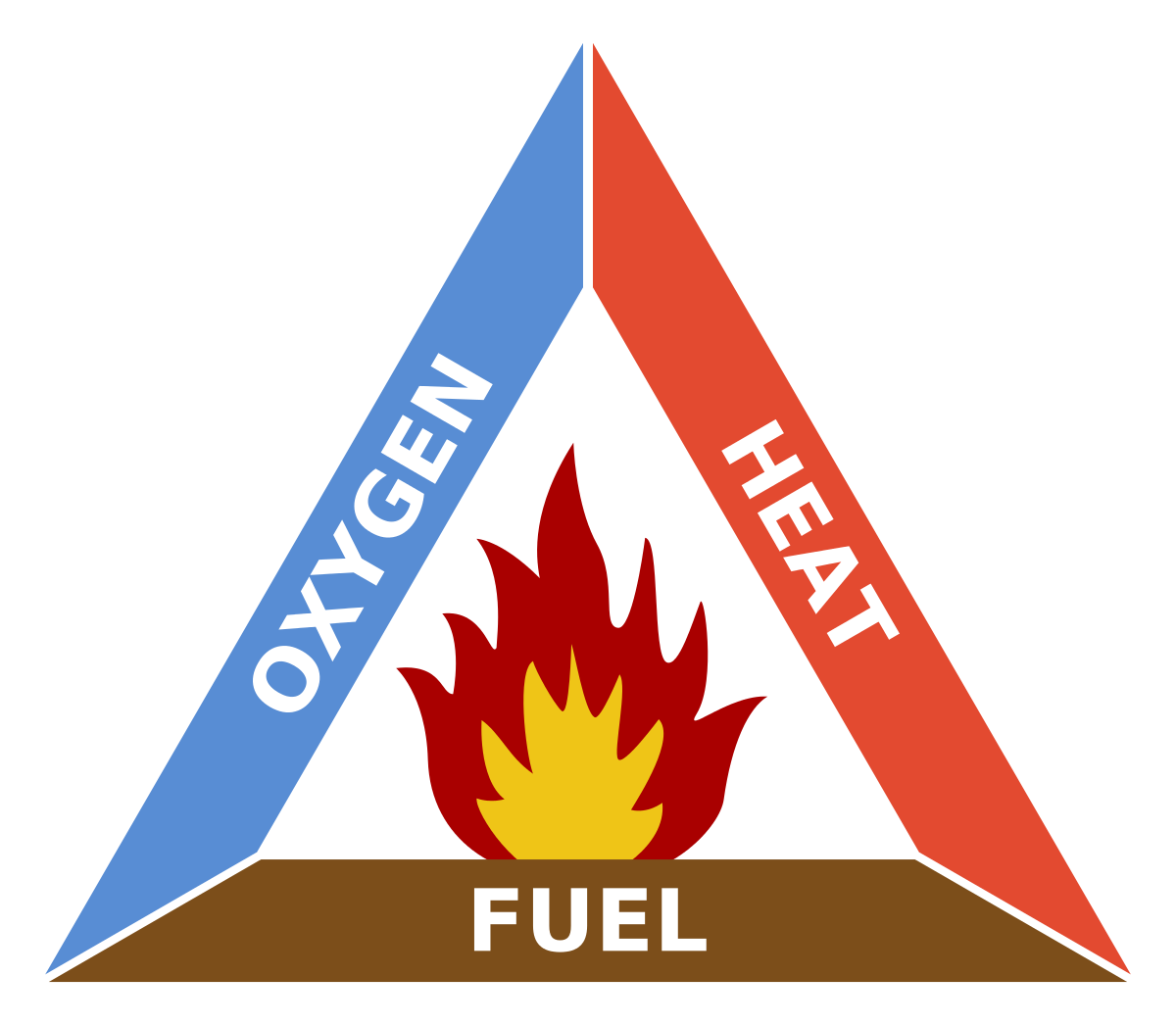
The fire triangle is a fundamental concept in fire science and safety that explains the three essential components required for a fire to ignite and continue burning. These three components are fuel, heat, and oxygen. To have a fire, all three elements must be present in the right proportions. If one of these components is removed or altered significantly, the fire will be extinguished. Let’s explore each component of the fire triangle in detail:
Fuel:
- Definition: Fuel is any substance that can burn and release energy in the form of heat when exposed to a heat source.
- Types of Fuel: Fuel can be solid (wood, paper, plastic), liquid (gasoline, oil), or gaseous (natural gas, propane). Different fuels have different properties and ignition points.
- Role in Fire: Fuel provides the material that undergoes combustion and sustains the fire. The type and quantity of fuel determine the intensity and duration of the fire.
Heat:
- Definition: Heat is the energy required to initiate the chemical reactions of combustion, which breaks down the fuel and releases heat in the process.
- Sources of Heat: Heat can come from various sources, such as open flames, electrical sparks, hot surfaces, friction, or chemical reactions.
- Role in Fire: Heat is necessary to raise the temperature of the fuel to its ignition point, at which it begins to release flammable gases and sustain the fire.
Oxygen (O2):
- Definition: Oxygen is an essential component of the Earth’s atmosphere and is required for the combustion process. It is a reactive gas that supports the chemical reaction that occurs during a fire.
- Role in Fire: Oxygen acts as an oxidizing agent. It combines with the fuel, allowing the combustion reaction to occur. The presence of sufficient oxygen ensures that the fire continues to burn.
The fire triangle concept is a simplified way to illustrate the interdependence of these three components. Each element is necessary, and altering any one of them can either prevent a fire from starting or extinguish an existing fire. For example:
- Removing Fuel: If you remove the fuel source, there is nothing to burn, and the fire will go out. This is the principle behind fire extinguishers, which often work by covering the fire with a substance that starves it of oxygen or cools it down.
- Removing Heat: If you remove the heat source, the fuel will not reach its ignition temperature, and the fire cannot start or will be extinguished. This can be achieved by cooling the fire with water or other extinguishing agents.
- Removing Oxygen: Reducing or displacing the oxygen concentration in the area can also extinguish a fire. This is how some fire suppression systems work, such as using inert gases to displace oxygen.
Understanding the fire triangle is crucial for fire safety and prevention. By recognizing the importance of fuel, heat, and oxygen in the fire process, individuals can take appropriate measures to minimize fire hazards, extinguish fires, or even engineer systems to prevent fires from occurring in the first place.
How is Fire Triangle useful?
The Fire Triangle concept is not typically used directly for extinguishing fires but rather as a framework for understanding the fundamental principles of combustion. However, understanding the Fire Triangle can indirectly help in extinguishing fires by guiding firefighting strategies and the selection of appropriate fire suppression methods. Here’s how it can help with examples:
- Removing Fuel:
- Suppose a small kitchen fire starts on a stovetop due to cooking oil. To extinguish this fire, you can turn off the stove or use a fire extinguisher. By turning off the stove, you remove the heat source. Using a fire extinguisher removes the oxygen from the immediate vicinity of the fire, effectively suffocating it. In this case, you’re removing the fuel source or disrupting the supply of oxygen.
- Removing Heat:
- If you have a grease fire in the kitchen, pouring water on it would be a poor choice because water can’t cool the fire down enough to remove the heat. However, using a Class K fire extinguisher, which releases a cooling agent like a mist or foam, can effectively remove the heat by cooling the flames. By reducing the heat source, you prevent the fire from sustaining itself.
- Removing Oxygen:
- In an industrial setting, if a fire breaks out in a room with a specialized fire suppression system, such as a clean agent fire suppression system, it can effectively remove oxygen from the environment. Clean agents, like halon or inert gases, displace the oxygen, creating an atmosphere where combustion cannot occur. This type of fire suppression directly targets the oxygen component of the fire triangle.
- Modifying Fuel Sources:
- In a forest fire scenario, firefighters may use a technique called backburning. They intentionally start a controlled fire in the path of the approaching wildfire. This controlled fire consumes the available fuel, creating a barrier that prevents the wildfire from spreading further. By reducing the available fuel, the uncontrolled fire’s progress can be slowed or stopped.
- Enhancing Firefighter Safety:
- Firefighters also use the Fire Triangle concept to assess the risks involved in a fire situation. Understanding that fire needs fuel, heat, and oxygen helps them make informed decisions about whether it’s safe to enter a burning building or area. For example, a building with a weakened structure might not be safe to enter because the firefighters could provide the missing oxygen source (by opening a door or window), potentially making the situation more dangerous.
In summary, the Fire Triangle concept helps guide firefighting efforts by providing a framework for understanding the three essential elements of a fire. Firefighters and other first responders use this knowledge to choose the most appropriate methods for extinguishing fires, which may involve removing or disrupting one or more of the elements in the triangle to bring the fire under control or put it out completely.